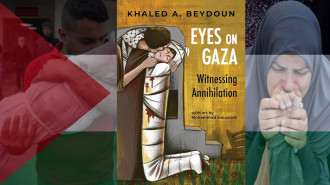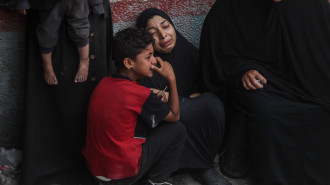
Arab World Institute in Paris honours 50 years of Moroccan artist Mehdi Qotbi with major retrospective exhibition

The military academy of Kenitra, about 60 kilometres north of Rabat, is the most unlikely place to discover one’s artistic vocation. But that was precisely what happened to Moroccan painter Mehdi Qotbi.
It was in his teenage years at the academy that he was allowed to paint a wall. Out of sudden inspiration, he painted the image of a tiger, which looked like it was almost jumping out of the plaster. “That tiger changed my existence,” he recalls.
“This was the day I could show my comrades, without deliberately wanting to, that I knew how to paint. From that moment on, they started having a completely different consideration of me," he pauses. "For the first time, I existed in the eyes of others.”
A buoyant, high-spirited man, with an emphatic and theatrical manner of speaking, Moroccan painter Mehdi Qotbi has over the years created a recognisable artistic style, blending the worlds of abstract painting and calligraphy.
His 50 years of relentless artistic creation will be celebrated by The Institut du Monde Arabe in Paris, which will present a major retrospective exhibition, running from October 15, 2024, to January 5, 2025.
"My teacher at the Beaux-Arts in Toulouse told me: you have nothing more to prove, you have to be yourself"
The show will offer a deep dive into Mehdi's exuberant art, which transcends the boundaries between different cultures, languages, and artistic traditions. His letters and symbols, the constituent elements in his canvases, seem to dance and swirl across his canvases, in an original mix of Arabic script and abstraction, hypnotising and mesmerising viewers.
In the catalogue for the exhibition, the President of the Institut du Monde Arabe, Jack Lang, describes Mehdi Qotbi as a "master of colours" and a creator who "choreographs" his brushstrokes to reinvent language through art.
Visitors to the exhibition will be able to experience a journey through Mehdi’s evolution as an artist, from his early works in the 1960s to his more recent explorations in painting, tapestry, and ceramics, as well as the collaborations he had with prominent writers and poets, such as Andrée Chédid, Jacques Derrida, and Léopold Sédar Senghor, reflecting his deep engagement with literature.
Beginnings and early influences
Mehdi’s artistic journey began in his native Morocco, where he grew up surrounded by the colours and geometric patterns of traditional architecture, textiles, and crafts. His mother, who he dearly loved, was one of his early influences as the young child observed her weaving carpets for a living.
The artist's childhood was marked by difficult circumstances, including violence and widespread poverty. “I was born into a modest family in a very working-class neighbourhood of Rabat,” recounts the artist, whose curiosity wasn’t debilitated by the struggles, but almost fortified and used as a means to escape his thoughts every day.
“When I went shopping for my parents, I took the opportunity to be able to wander around."
On these walks, he was mesmerised by storefronts with calligraphy indicating the butcher or the pharmacy. "I found it very pretty, because at the time — more than 50 years ago — people tried to make the façade of their shop as beautiful as possible, and they embellished it with writing. This was a strong imprinting that later on deeply influenced me.”
Deciding to escape Morocco, which didn’t offer him any chance to develop as an artist, he moved to Toulouse, where he continued his education and artistic development.
It was in France that he finally freed himself from the concept of making art exist in the eyes of others; a self-inflicted destiny that loomed onto him with that first tiger at the military barracks in Kenitra: “My teacher at the Beaux-Arts in Toulouse told me: you have nothing more to prove, you have to be yourself,” says Mehdi.
His first years in France also saw his first encounter with the work of Claude Monet, especially Les Nymphéas, which influenced the artist's production in terms of the use of light and colour, today hallmarks of his paintings in their interplay with Arab writing.
"Note that I didn’t use the word 'calligraphy,'” says the artist. “Calligraphy has two meanings: the beauty of the letter and also the signifier of the letter. In my art, there is no linguistic meaning. It's just a sign, a kind of music without words. Arabic writing is very musical. When you look at it, you have the impression that it is a musical score.”
"I personally think, without going too far, that the Moroccan art scene is the richest and most interesting scene in the Arab world"
In Mehdi's paintings, we can, in fact, see the letters dissolve into abstract forms, inviting us to engage directly with the emotions and aesthetics of the form, rather than a poetic meaning like with traditional art of calligraphy.
Harmony through art
With his art, Mehdi represents a bridge between France and Morocco, the Arab world, and the West. “I love Morocco. I love this country that is constantly evolving. Given the luck that I have had through my painting, I love that people get some of its spirit through my work.”
He finds the art scene in Morocco today extremely lively, with more and more artists reaching international success. “I personally think, without going too far, that the Moroccan art scene is the richest and most interesting scene in the Arab world,” he says. “His Majesty the King gave an extraordinary impulse to the development of the art scene, and he remains the first collector of the country.”
While it was the king who nominated him as the president of the National Museums Foundation of the Kingdom of Morocco (FNM), his love for museums dates back to his youth, when he found unparalleled solace and serenity in the Museum of Archaeology in Rabat.
To this day Mehdi considers museums to be the second most peaceful place for him. The first is of course his atelier, which he visits almost daily after a harmonious routine.
“Before people wake up, before the day breaks, I always get up to enjoy this silence,” says the artist. “I have a space at home, in my home, with a garden, and that's where each morning I do my sport. Those 40 minutes provide me enough serenity to carry on for the entire day.”
Another pillar of the architecture of his day is music, in particular Egyptian singer Umm Kulthum. “Her voice is in my genes. I can't start my day without listening to her,” he says. “And in the evening, when I'm alone and I read – another activity which brings me peace – I mainly listen to Maria Callas.”
These days, he tries to paint a little every day. However, his latest artwork, a small painting called The Light of Happiness, is not meant for a big show, but it's rather a special gift for his newborn grandson.
This little piece ultimately carries the same spirit of that first little tiger on the wall of Kenitra's barracks – before it was acknowledged by his peers. Namely, making art with no other aim than the expression and feeling appeased. And from that harmonious place inside one's self, connect with the rest of the world.
The artist thinks that his eclecticism, and his open-mindedness towards the world, are directly connected to his roots. “Morocco is a country open to two seas, the Atlantic and the Mediterranean,” he concludes.
“Being born there has gifted me this spirit of openness, to welcome others, and that is what I want to share with my art.”
Naima Morelli is an arts and culture writer with a particular interest in contemporary art from the Middle East, North Africa and the Asia-Pacific region. She is also the author Arte Contemporanea in Indonesia, un’introduzione and The Singapore Series: a contemporary art reportage
Follow her on X: @naimamorelli






 Follow the Middle East's top stories in English at The New Arab on Google News
Follow the Middle East's top stories in English at The New Arab on Google News


